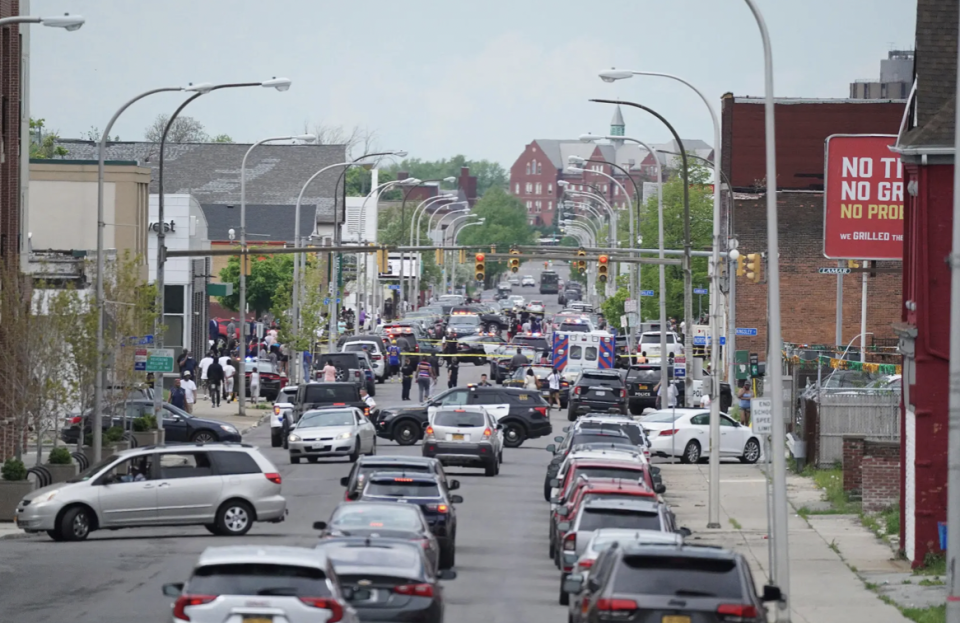News Take Action
The New York Times: "Gunman targeted Black neighborhood shaped by decades of segregation"
| Date: | May 15, 2022 |
| Share: |

By: Anushka Patil| May 15, 2022
The high concentration of Black residents on Buffalo’s East Side — which the suspect in Saturday’s mass shooting said was his reason for targeting the area — is a direct result of decades of segregation and systemic racism, researchers have consistently found.
One analysis from the University of Michigan, based on data from the 2010 census, found that the Buffalo-Niagara Falls metro area was the nation’s sixth most segregated when ranked specifically by the distribution of Black and white residents.
Segregation is also a root cause, according to experts, of why efforts to bring an economic renaissance to Buffalo have done little for Black residents. A University at Buffalo report in 2021 found that living conditions for Black residents of the city, across measures of health, housing, income and education, had improved little and in some cases had declined over the preceding 30 years.
India B. Walton, a nurse and community activist who nearly unseated Buffalo’s four-term Democratic mayor last year, called the city “segregated by design” as she reacted to the shooting on Twitter.
“Our government can’t prevent things that they actually cause,” she wrote.
Indeed, like many major American cities, Buffalo bears a tell-tale scar of long-standing segregation, a highway built in the 1950s and 1960s that cut directly through a Black neighborhood, severing those communities and stifling economic development for decades to come.
That highway, the Kensington Expressway, is about two blocks from the Tops supermarket where at least 10 people were shot and killed on Saturday. (Also near the scene of the shooting is City Honors School, a magnet institution that has ranked regularly as one of the best schools in the country and has struggled to improve its disproportionately low Black enrollment.)
The destruction caused by the creation of the Kensington Expressway included the razing of Humboldt Parkway, a tree-lined public space designed by the legendary architect Frederick Law Olmsted. It has been described as the “spine” of the Black middle-class neighborhood that was emerging at the time.
The destruction caused by the creation of the Kensington Expressway included the razing of Humboldt Parkway, a tree-lined public space designed by the legendary architect Frederick Law Olmsted. It has been described as the “spine” of the Black middle-class neighborhood that was emerging at the time.
Pollution from the expressway, which helped give residents of mostly white suburbs easy access to the city center, has done long-term damage to the health of the people living near it. The road also cut Black residents of the East Side off from key community institutions like banks and grocery stores, according to a 2018 report from the Partnership for the Public Good.
The very existence of the Tops grocery store was a hard-won victory for East Siders. The neighborhood is a food desert, and residents had been campaigning for a store like Tops for more than a decade when it finally opened in 2003, according to The Buffalo News.
The dearth of options helped make Tops a neighborhood establishment. Many families were shopping for their Sunday dinners there when the shooting began. The suspected gunman said in his manifesto that, in addition to targeting the area for its Black population, he had researched the days and times when Tops was busiest.
The Buffalo Community Fridge network, a mutual aid group that stocks community refrigerators with fresh produce and prepared meals for neighbors — including one that is less than half a mile from Tops — said it received many donations on Saturday, after its call to support residents affected by the shooting was shared on social media.
The group is organizing volunteers to buy and distribute food in the area on Sunday.
William K. Rashbaum and Alexandra E. Petri contributed reporting.
To read the full article and see additional coverage on The New York Times website, click here.
Read the referenced report, 'A City Divided: A Brief History of Segregation Buffalo" here.
Image: Near the scene of the mass shooting on Buffalo's East Side on Saturday. Photo Credit: Derek Gee/The Buffalo News